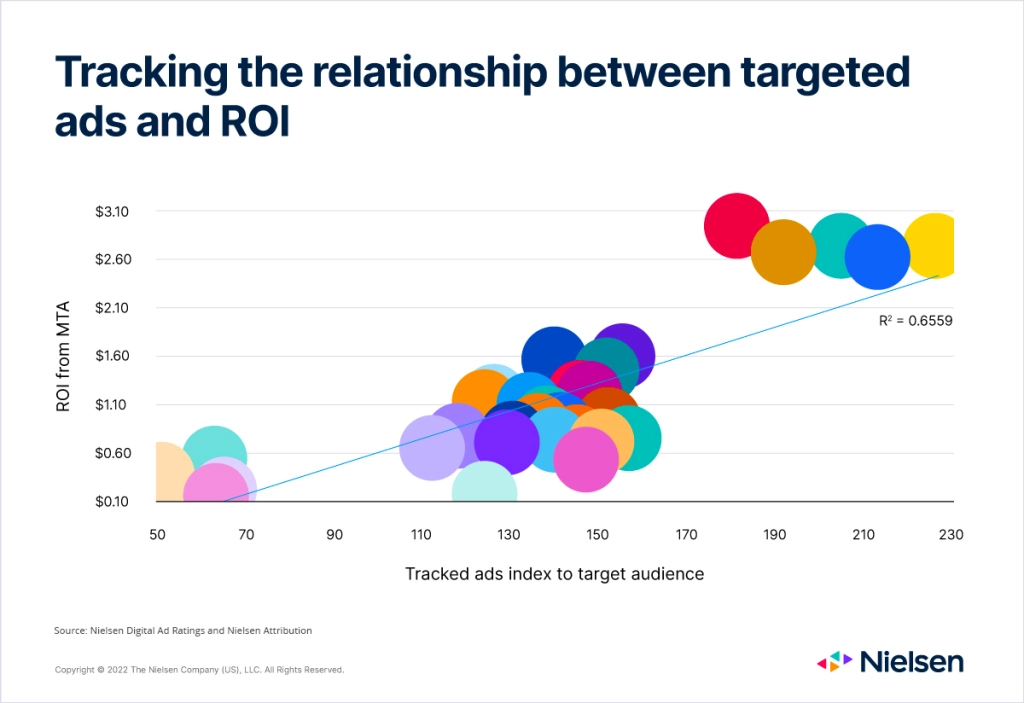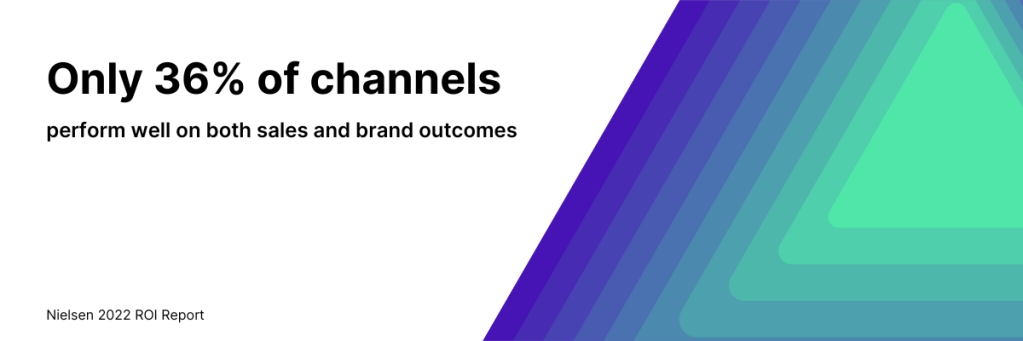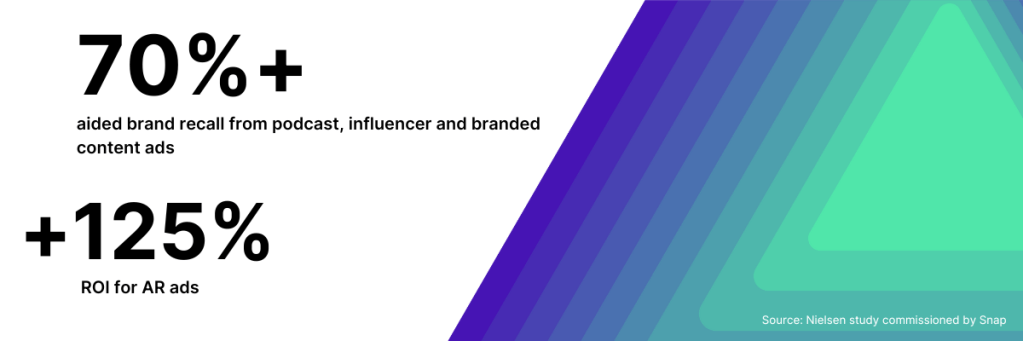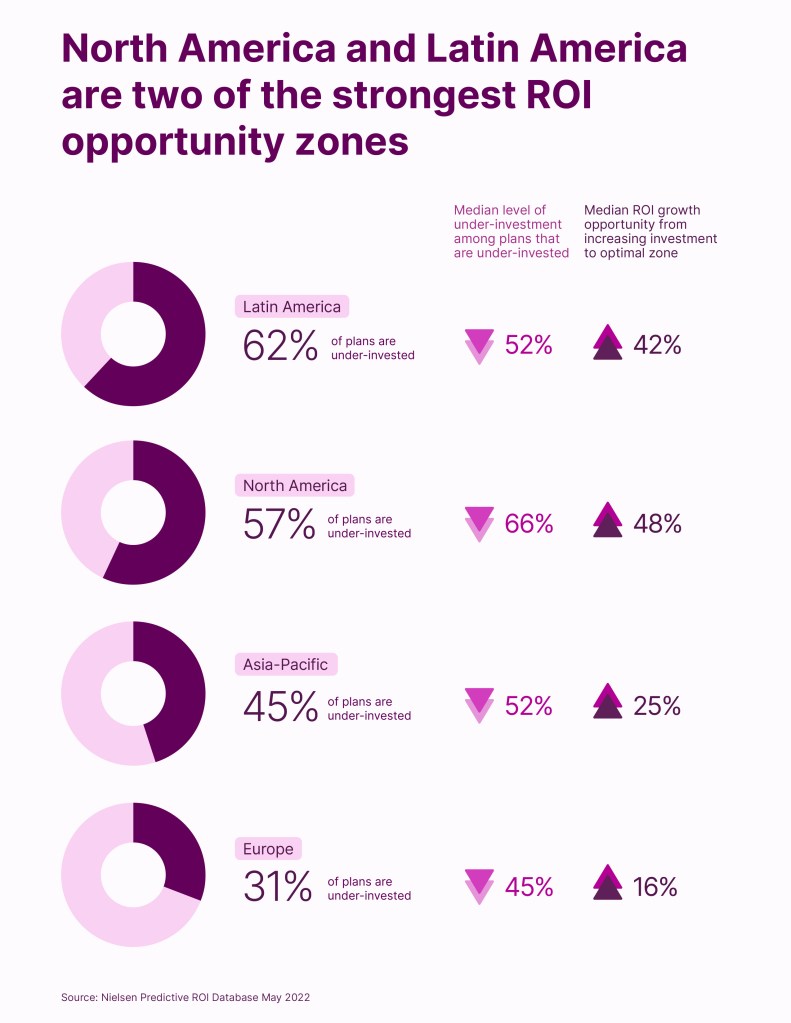The fragmented media landscape and sheer volume of new platforms, channels and services has made tracking ROI increasingly complex for marketers. And, while technology to engage, measure, optimize and prove ROI has never been more plentiful, only 54% of global marketers say they are confident in their ability to measure full-funnel ROI.
Given the ever-expanding list of sources for consumer data, it’s easy to see why marketers find it difficult to glean insights from what are often disparate sets of data. To help cut through the data noise, we’ve put together six tips and best practices you can use that harness the power of data to increase ROI.
Tip 1: Improve targeting to increase ROI
Trying to stretch your marketing budget to cover the constantly expanding media landscape is a challenge. That’s why it’s important to understand the unique reach and frequency of your advertising campaigns across publishers and platforms. According to Nielsen Digital Ad Ratings (DAR), nearly 40% of digital advertising budgets are wasted on the wrong audiences, and targeting efficiency is a strong indicator of ROI performance.
In a data-driven marketing era, leveraging in-flight indicators to optimize your campaign in near real time is the key to reaching more of your target audience, and increasing ROI. Nielsen recently conducted an analysis to validate that if you deliver the right ad to the right audience, you will improve your ROI, confirming that audience metrics are an early indicator of campaign performance.

In the study, we found that ad partners that served fewer ads to their target audience (lower left cluster) saw an average ROI of $0.25 per $1 spend, while those who delivered more ads to their target audience (upper right cluster) realized an average ROI of $2.60 per $1 spent.
Tip 2: Measure and maximize brand metrics
Building brand awareness is the top objective for global marketers in 2022, and it’s easy to see why: Nielsen data shows that, on average, a 1-point gain in brand metrics such as awareness and consideration drives a 1% increase in sales. What’s more, awareness and consideration growth improve conversion-oriented marketing efficiency.
But brands today often measure media’s impact on sales and infrequently measure media’s impact on brand. That’s dangerous because channels rarely perform well on both sales and brand outcomes—in fact this only happens in 36% of cases. To unlock a campaign’s full potential, marketers must use a varied mix with channels that drive both ends of the funnel.

For additional insights, download the Nielsen 2022 ROI Report.
In the face of inflationary pressures, it’s tempting to use incentives and promotions to realize short-term sales lift. But it’s important to remember that ROI is a long game, and media plans that balance those short-term lifts with continual brand building will realize better outcomes.
Running marketing mix models (MMMs) will help optimize channel mix for short term-sales, and a second analysis can then be done to optimize channel mix for awareness or other upper-funnel metrics. This approach addresses the need to meet short-term sales goals while seeding long-term growth through brand building.
Tip 3: Use creative to drive sales
In an increasingly fragmented media landscape where consumers see an overabundance of ad clutter, getting—and keeping—their attention often comes down to creative excellence.
A recent Nielsen study, commissioned by Meta, examined three years’ of marketing mix modeling data for 41 brands across a wide range of CPG categories and found that campaigns with high-quality creative achieved 35% greater effectiveness.

Tip 4: New media = new ways to engage
With the wealth of new media platforms and formats available to consumers, marketers have more ways to engage with potential buyers than ever before. And with each new marketing channel, attribution and optimization become critical for identifying which formats will drive the most ROI.
Brands that are investing in newer media and formats are seeing big returns. For example, a Nielsen and Snap study found Augmented Reality ads drove substantially higher ROI than other media, and a Nielsen study with TikTok found brands executing multiple ad formats for their TikTok campaigns drove as much as 12% higher return on ad spending, compared with brands that focused only on an individual ad format. Nielsen’s 2022 ROI Report shows that podcast ads, influencer marketing and branded content ads are also impactful at driving brand metrics.

Tip 5: Optimize spend across regions to see ROI lift
Often brands think poor ROI means they should spend less. However, it may be the case that brands are spending too little to break through and have impact. Nielsen’s 2022 ROI Report found that 50% of media plans are underinvested by a median of 50%. But, if marketing teams committed the ideal amount of resources, their ROI could jump 50%.
There are even more distinctions when you break performance down by region. North America has the highest ROI levels of any of the regions we studied—despite 57% of plans showing under-investment—making it one of the strongest opportunity zones for most brands. Latin America also has tremendous opportunity, with more than half of plans showing under-investment and significant ROI upside from closing the gap.
Meanwhile, brands in Europe are least likely to be under-investing in media, but are posting the lowest ROIs of all the regions. These brands should invest in granular analytics that help them spot opportunities to grow ROI so that they more closely resemble levels in the rest of the world.

Tip 6: Leverage multiple data sets for deeper insights, better performance
The most effective marketing tactics combine the power of both behavioral and contextual data to drive the highest ROI. By complementing contextual data with high-quality, deterministically sourced behavioral data, marketers can be more effective and efficient with their marketing campaigns. In fact, according to Nielsen Attribution norms, impressions delivered to audiences using behavioral targeting produce higher ROI than impressions delivered using contextual targeting alone.
Gone are the days of “set it and forget it” marketing campaigns. To keep pace with rapidly changing consumer appetites, brands need adaptive strategies that can pivot and flex as audience behaviors shift. And, as with most marketing challenges, measuring channel effectiveness and optimizing your marketing campaigns becomes much more manageable with the right data—and the right tools to help turn that data into actionable insights.



